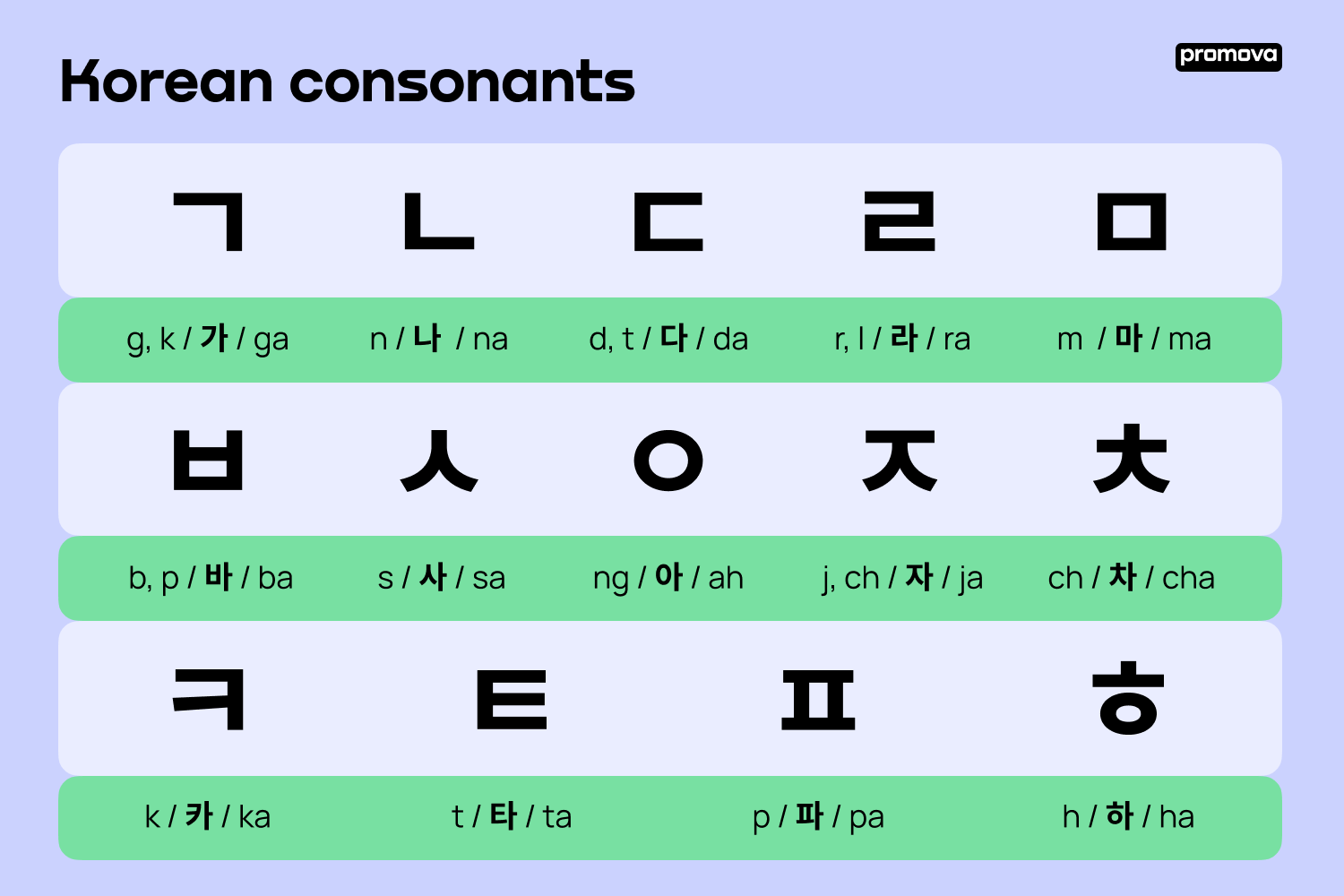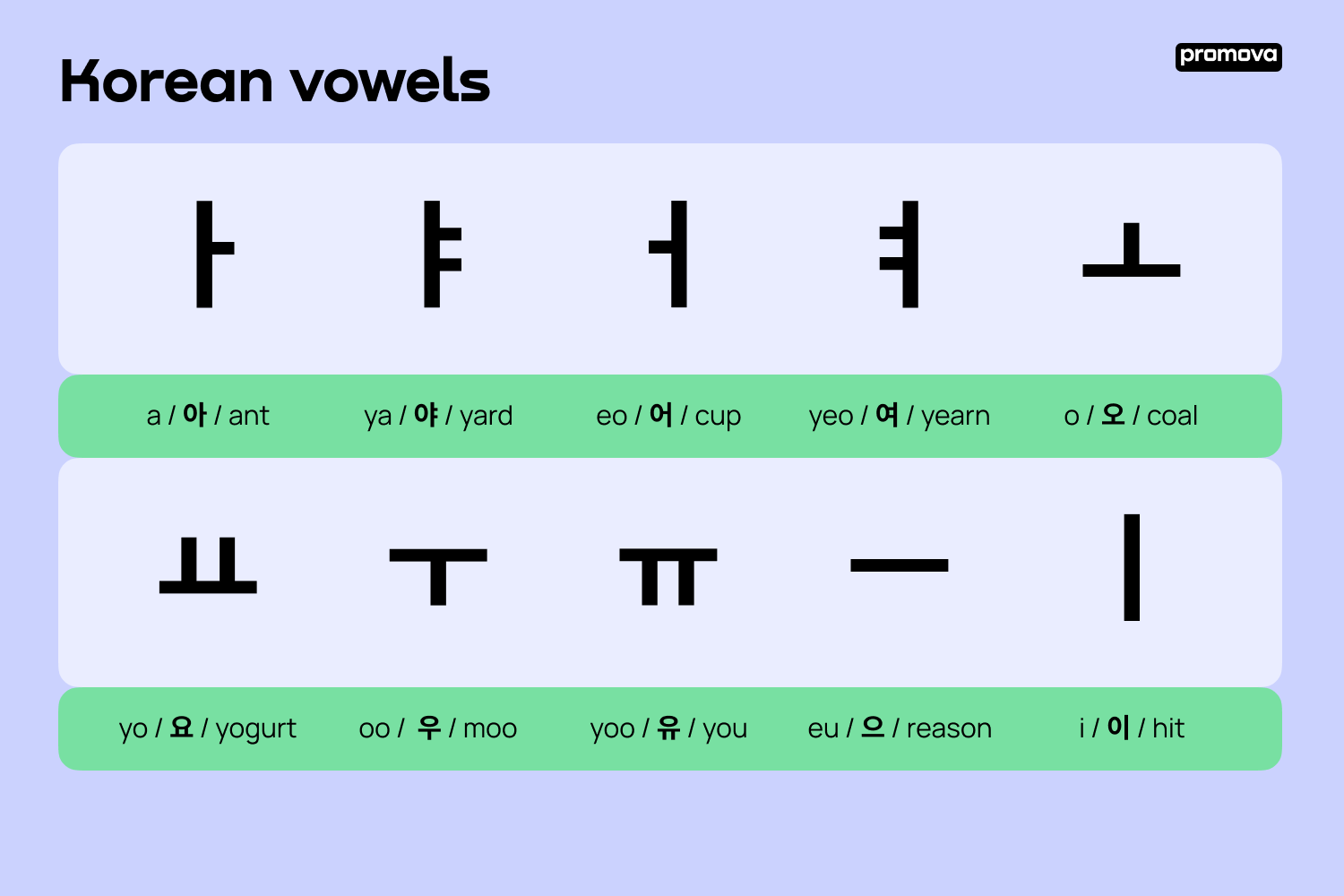Korean Alphabet
Contents
The Korean alphabet, Hangul, was created during the Joseon Dynasty in the 15th century. Unlike many Western alphabets that derive from Latin, Hangul is organized into blocks, each of which represents a syllable. Learning Hangul is the cornerstone of understanding the Korean language.
The Origin of Hangul
King Sejong the Great and his scholars developed Hangul in 1443 to promote literacy among the common people. Before Hangul, Classical Chinese characters were used, limiting literacy to the elite class. Hangul's creation was revolutionary, making reading and writing accessible to everyone.
The Structure of the Korean Alphabet
Let's take a closer look at the building blocks that make up Hangul.
Consonants
The Korean alphabet includes 14 basic consonants. You'll notice that some have a similar sound to English consonants. Here's a list to help you understand them:

| Consonant | Sound | Pronunciation | Pronunciation of Korean alphabet to English words |
| ㄱ | g/k | Initial /g/, final /k/ | "g" as in "go," "k" as in "book" |
| ㄴ | n | /n/ | "n" as in "no" |
| ㄷ | d/t | Initial /d/, final /t/ | "d" as in "dog," "t" as in "hat" |
| ㄹ | r/l | /r/ and /l/ | "r" as in "run," "l" as in "love" |
| ㅁ | m | /m/ | "m" as in "man" |
| ㅂ | b/p | Initial /b/, final /p/ | "b" as in "bat," "p" as in "tap" |
| ㅅ | s/t | Initial /s/, final /t/ | "s" as in "see," "t" as in "bat" |
| ㅇ | ng | /ŋ/ (null sound at the beginning of a syllable) | "ng" as in "song" |
| ㅈ | j/t | Initial /d͡ʑ/, final /t/ | "j" as in "jar," "t" as in "bat" |
| ㅊ | ch | /t͡ʃ/ | "ch" as in "chat" |
| ㅋ | k | /kʰ/ | "k" as in "kite" |
| ㅌ | t | /tʰ/ | "t" as in "top" |
| ㅍ | p | /pʰ/ | "p" as in "pat" |
| ㅎ | h | /h/ | "h" as in "hat" |
The consonants also have aspirated and double versions, adding complexity and richness to the language.
Vowels
The Korean alphabet has ten basic vowels, each with a unique sound and form. Understanding the basic vowels will help you read and write Korean words:

| Vowel | Sound | Pronunciation | Pronunciation of Korean alphabet to English words |
| ㅏ | a | /a/ | "a" as in "father" |
| ㅑ | ya | /ja/ | "ya" as in "yarn" |
| ㅓ | eo | /ʌ/ | "eo" as in "sun" (approximation) |
| ㅕ | yeo | /jʌ/ | "yeo" as in "yes" (approximation) |
| ㅗ | o | /o/ | "o" as in "go" |
| ㅛ | yo | /jo/ | "yo" as in "yoga" |
| ㅜ | u | /u/ | "u" as in "food" |
| ㅠ | yu | /ju/ | "yu" as in "you" |
| ㅡ | eu | /ɯ/ | No exact English equivalent |
| ㅣ | i | /i/ | "i" as in "see" |
These vowels can be combined with consonants to form various syllables in the Korean language.
Complex Korean Vowels
Diphthongs in the Korean language are combinations of vowels that produce a unique sound. They create a gliding effect from one vowel sound to another within the same syllable. It results in 11 unique vowels in the Korean alphabet.
| Vowel | Sound | Pronunciation | Pronunciation of Korean alphabet to English words |
|---|---|---|---|
| ㅐ | ae | /ɛ/ | "ae" as in "bat" |
| ㅒ | yae | /jɛ/ | "yae" as in "yeah" |
| ㅔ | e | /e/ | "e" as in "bed" |
| ㅖ | ye | /je/ | "ye" as in "yes" |
| ㅘ | wa | /wa/ | "wa" as in "water" |
| ㅙ | wae | /wɛ/ | "wae" as in "wet" |
| ㅚ | oe | /ø/ or /we/ | Similar to "we" (approximation) |
| ㅝ | wo | /wʌ/ | "wo" as in "word" (approximation) |
| ㅞ | we | /we/ | "we" as in "wet" |
| ㅟ | wi | /wi/ | "wi" as in "we" |
| ㅢ | ui | /ɯi/ | No exact English equivalent |
These vowels play an essential role in accurately representing the phonetics of words and are vital in differentiating meanings. They are often considered a feature that adds to the melodic quality of the Korean language, giving it a unique phonetic character distinct from other languages.
Forming Korean Syllables
Learning how to form Korean characters is a vital step in mastering the Korean language. Unlike alphabets that arrange letters linearly, the Korean alphabet builds characters using syllabic blocks. These blocks combine consonants and vowels to represent individual sounds, and the characters align into three main structures.
- Vertical Structure
- Example: 모 (mo)
- Formation: In this structure, the consonant is positioned at the top, and the vowel is placed below it, forming a vertical alignment.
- Consonant: ㅁ (m)
- Vowel: ㅗ(o)
- Result: The combination of these elements results in 모, pronounced as "mo."
- Horizontal Structure
- Example: 나 (na)
- Formation: In this arrangement, the consonant is on the left, and the vowel is on the right, creating a horizontal alignment.
- Consonant: ㄴ (n)
- Vowel: ㅏ (a)
- Result: The combination forms 나, pronounced as "na."
- Complex Structure (Square Structure)
- Example: 간 (gan)
- Formation: This structure combines both vertical and horizontal alignments. The initial consonant is on the top, followed by the vowel to its right, and a final consonant beneath.
- Initial Consonant: ㄱ (g)
- Vowel: ㅏ (a)
- Final Consonant: ㄴ (n)
- Result: The complete character is 간, pronounced as "gan."
- Complex Structure with Two Final Consonants (Square Structure with Two Bottom Elements)
- Example: 밟 (balb)
- Formation: In this sophisticated arrangement, an initial consonant is placed at the top, followed by a vowel to its right, and two final consonants beneath in a horizontal alignment.
- Initial Consonant: ㅂ (b)
- Vowel: ㅏ (a)
- Final Consonants: ㄹ (l) and ㅂ (b)
- Result: The complete character is 밟, pronounced as "balb."
These primary structures provide the foundation for forming all Korean characters. By understanding and practicing these formations, you'll be able to read and write Korean symbols.
Featural System: Consonant Shapes and Articulation
One of the unique characteristics of Korean letters is their featural design, where the shapes of the characters are related to the articulatory phonetics of the sounds they represent. This is especially evident in the design of consonants.
For example, the basic shapes of the three consonants ㄱ (g/k) and ㄴ (n) represent different places of articulation within the mouth. The symbol ㄱ(g/k) looks like the tongue blocking the throat, which is how the /g/ sound is produced. The symbol ㄴ((n) resembles the tongue raised against the upper edge of the teeth to make the /n/ sound.
This design, where the shape of the Korean letters mirrors their articulation, makes Hangul a highly intuitive writing system. It allows for a visual understanding of how the sounds are produced, enhancing the learning experience and offering a remarkable example of how writing can be closely linked to speech. It’s an aspect that sets Hangul alphabet apart from many other writing systems and contributes to its reputation as a logical and scientifically designed alphabet.
Regional Variations: Differences in Usage and Spelling in North and South Korea
In North Korea, efforts to preserve the purity of the language have led to a preference for native Korean words and the elimination of many foreign loanwords. In contrast, South Korea has been more open to foreign influences. The two countries have also developed differences in spelling, with North Korea often adhering to older writing rules while South Korea has adopted some spelling reforms. Here are some examples:
- "Corn":
- South Korea: 옥수수 (oksusu)
- North Korea: 강냉이 (gangnaengi)
- "Factory":
- South Korea: 공장 (gongjang)
- North Korea: 창공 (changgong)
While the language remains mutually intelligible, the differences are significant enough to be noticeable and can pose challenges to learners attempting to navigate the details of regional usage.
15
Learn Korean with Promova
Are you fascinated by the rich history, intricate Korean characters, and mellifluous sounds of the Korean language? Whether you're a beginner or looking to take your Korean language skills to the next level, Promova has got you covered. Promova is an innovative language platform tailored to your learning needs, helping you immerse yourself in Korean language and culture.
At Promova, we understand that language learning is always a challenge, and we've designed a suite of resources to match your individual pace and preferences. Our learning tools include:
- Quizzes: learn the Korean symbols with interactive quizzes, from beginner levels to advanced, to reinforce your understanding of vocabulary, grammar, and more.
- Flashcards: our flashcards feature Hangul characters, pronunciation guides, and English translations. These cards make memorizing Korean words and phrases both fun and effective.
- Listening Exercises: improve your listening skills and familiarize yourself with authentic Korean accents with our curated listening exercises, ranging from simple dialogues to real-life conversations.
- Cultural Features: we believe that language learning goes hand in hand with cultural understanding. Explore Korean customs, traditions, and history through engaging lessons, videos, and articles to discover more about Korean alphabet and language development.
- Community Support: Engage with fellow learners through our community chat. Share your experiences, ask questions, and receive personalized guidance.
With Promova, learning Korean becomes a delightful and rewarding experience. Our platform adapts to your needs, allowing you to customize your learning path and track your progress. Whether you want to learn Korean for travel, business, or personal enrichment, Promova's holistic approach ensures that you not only learn the language but also connect with its heart and soul.
Conclusion
The Hangul alphabet is a fascinating script that is both logical and visually pleasing. As you embark on your journey to learn Korean, understanding the Hangul alphabet will be an essential step. You'll find that with dedication and the right approach, and you'll be reading and writing Korean in no time.
Remember, the road to learning a new language is filled with challenges but also many rewards. Embrace the adventure, and dive into the captivating world of Hangul.
Comments